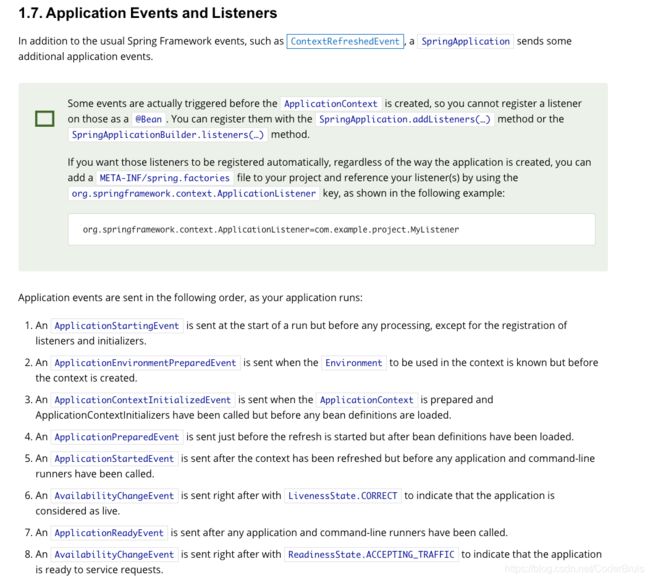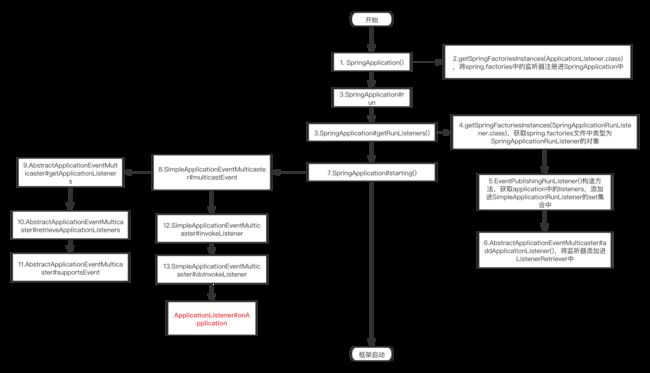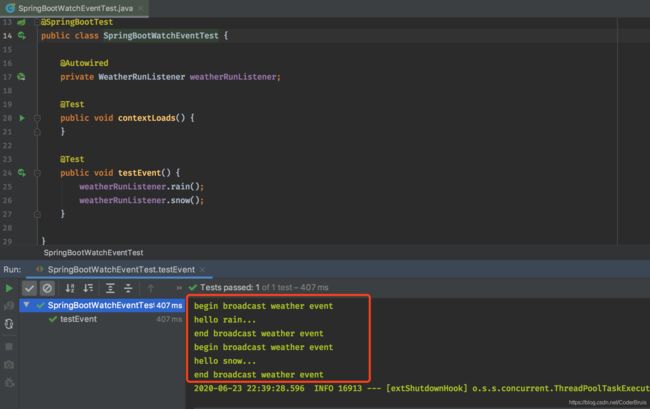深入SpringBoot源码学习之——监听器与事件机制
前言
先看下Spring官方文档对于事件以及监听器的解释与说明。
监听器官方说明
- 除了通常的Spring框架自带的事件例如:ContextRefreshedEvent,SpringApplication还会发送一些额外的事件。
- 对于事件的监听,需要通过监听器来实现。在SpringBoot中,监听器可以通过三种方式来注册,
① 通过SpringApplication.addListeners(…)
② 通过SpringApplicationBuilder.listeners(…)
③ 通过注册在META-INF/spring.factories中,示例为org.springframework.context.ApplicationListener=com.example.project.MyListener - 监听器不能以Bean的形式注册进SpringIOC容器中,因为监听器是在ApplicationContext上下文创建成功之前调用的。
- Spring应用程序的内置事件会以以下顺序发送:
① ApplicationStartingEvent
② ApplicationEnvironmentPreparedEvent
③ ApplicationContextInitializedEvent
④ ApplicationPreparedEvent
⑤ ApplicationStartedEvent
⑥ AvailabilityChangeEvent
⑦ ApplicationReadyEvent
⑧ AvailabilityChangeEvent
⑨ ApplicationFailedEvent
除了上面这些绑定在SpringApplication上的事件外,还有ContextRefreshedEvent和WebServerInitializedEvent、ServletWebServerInitializedEvent、ReactiveWebServerInitializedEvent等事件在ApplicationPreparedEvent和ApplicationStartedEvent事件之间发布。
在介绍完SpringBoot的官方文档后,下面看看SpringBoot源码中监听器是如何实现的。
正文
1. SpringBoot通过factories注册的监听器
在前面已经讲解过了SpringFactoriesLoader加载spring.factories的原理机制,大家都清楚了SpringFactoriesLoader会加载spring.factories中注册的初始化器、监听器、后置处理器等组件,在SpringApplication的构造方法中会通过JDK的反射工具实例化这些组件。
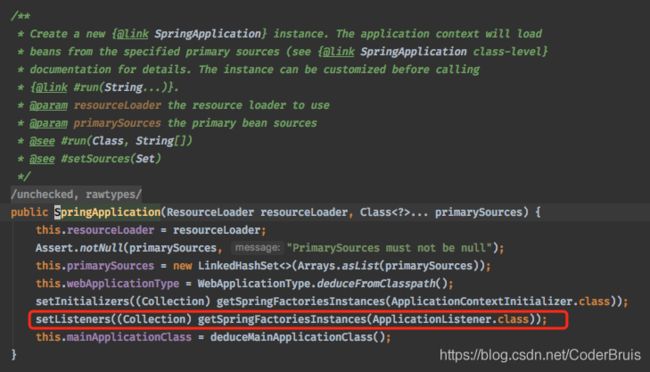
从源码中可以看到,SpringBoot在SpringApplication的构造方法中,会先获取ApplicationListener类型的监听器,并存进SpringApplication对象中,用于后续操作的调用。
下面看看ApplicationListener接口定义信息
/**
* Interface to be implemented by application event listeners.
*
* Based on the standard {@code java.util.EventListener} interface
* for the Observer design pattern.
*
*
As of Spring 3.0, an {@code ApplicationListener} can generically declare
* the event type that it is interested in. When registered with a Spring
* {@code ApplicationContext}, events will be filtered accordingly, with the
* listener getting invoked for matching event objects only.
*
* @author Rod Johnson
* @author Juergen Hoeller
* @param the specific {@code ApplicationEvent} subclass to listen to
* @see org.springframework.context.ApplicationEvent
* @see org.springframework.context.event.ApplicationEventMulticaster
* @see org.springframework.context.event.EventListener
*/
@FunctionalInterface
public interface ApplicationListener extends EventListener {
/**
* Handle an application event.
* @param event the event to respond to
*/
void onApplicationEvent(E event);
}
注释大致意思为:
ApplicationListener接口是用于定义Spring应用程序监听器的接口,是基于Observer(观察者)设计模式的标准接口。从Spring3.0开始,ApplicationListener可以声明感兴趣的事件类型。
注册完spring.factories配置文件中的监听器后,SpringBoot框架是什么时候开始获取监听器然后调用监听器的监听的事件呢?下面来看SpringApplication#run方法。
重点需要关注下ApplicationListener#onApplicationEvent方法,这个方法是广播器播放监听器时调用的方法,详情会在下文中讲解。
SpringApplication#getRunListeners

这个方法就是通过SpringFactoriesLoader去加载spring.factories配置文件中的文件指定的SpringApplicationRunListener类类型,这里获取的就是EventPublishingRunListener:
# Run Listeners
org.springframework.boot.SpringApplicationRunListener=\
org.springframework.boot.context.event.EventPublishingRunListener
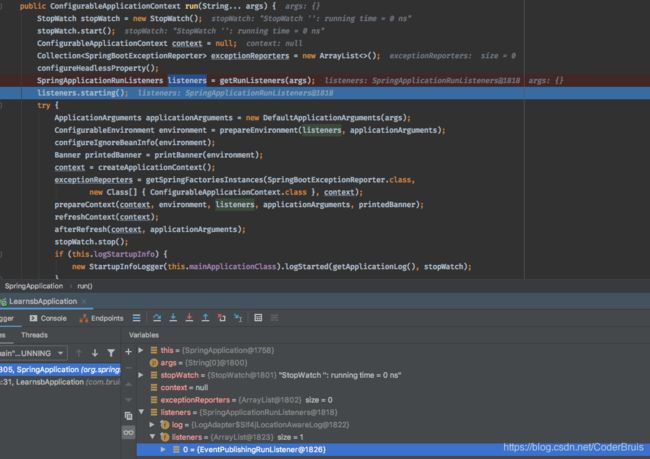
EventPublishingRunListener有什么作用?
1.1 EventPublishingRunListener
下面先看下EventPublishingRunListener源码
/**
* SpringApplicationRunListener 是用于发布 SpringApplicationEvent的。
* SpringApplicationRunListener通过内部的ApplicationEventMulticaster在容器刷新之前来触发事件。
*
* @author Phillip Webb
* @author Stephane Nicoll
* @author Andy Wilkinson
* @author Artsiom Yudovin
* @since 1.0.0
*/
public class EventPublishingRunListener implements SpringApplicationRunListener, Ordered {
private final SpringApplication application;
private final String[] args;
// 事件播放器
private final SimpleApplicationEventMulticaster initialMulticaster;
public EventPublishingRunListener(SpringApplication application, String[] args) {
this.application = application;
this.args = args;
this.initialMulticaster = new SimpleApplicationEventMulticaster();
// 获取SpringApplicaiton中实例化的事件监听器,添加进事件播放器中。listeners集合最终会存于AbstractApplicationEventMulticaster类中一内部类的一个Set集合中。
for (ApplicationListener listener : application.getListeners()) {
this.initialMulticaster.addApplicationListener(listener);
}
}
@Override
public int getOrder() {
return 0;
}
/**
* 通过事件播放器播放ApplicationStartingEvent事件
*/
@Override
public void starting() {
this.initialMulticaster.multicastEvent(new ApplicationStartingEvent(this.application, this.args));
}
/**
* 通过事件播放器播放ApplicationEnvironmentPreparedEvent事件
*/
@Override
public void environmentPrepared(ConfigurableEnvironment environment) {
this.initialMulticaster
.multicastEvent(new ApplicationEnvironmentPreparedEvent(this.application, this.args, environment));
}
/**
* 通过事件播放器播放ApplicationContextInitializedEvent事件
*/
@Override
public void contextPrepared(ConfigurableApplicationContext context) {
this.initialMulticaster
.multicastEvent(new ApplicationContextInitializedEvent(this.application, this.args, context));
}
/**
* 通过事件播放器播放ApplicationPreparedEvent事件
*/
@Override
public void contextLoaded(ConfigurableApplicationContext context) {
for (ApplicationListener listener : this.application.getListeners()) {
if (listener instanceof ApplicationContextAware) {
((ApplicationContextAware) listener).setApplicationContext(context);
}
context.addApplicationListener(listener);
}
this.initialMulticaster.multicastEvent(new ApplicationPreparedEvent(this.application, this.args, context));
}
/**
* 通过事件播放器播放ApplicationStartedEvent事件
*/
@Override
public void started(ConfigurableApplicationContext context) {
context.publishEvent(new ApplicationStartedEvent(this.application, this.args, context));
}
/**
* 通过事件播放器播放ApplicationReadyEvent事件
*/
@Override
public void running(ConfigurableApplicationContext context) {
context.publishEvent(new ApplicationReadyEvent(this.application, this.args, context));
}
/**
* 通过事件播放器播放ApplicationFailedEvent事件
*/
@Override
public void failed(ConfigurableApplicationContext context, Throwable exception) {
ApplicationFailedEvent event = new ApplicationFailedEvent(this.application, this.args, context, exception);
if (context != null && context.isActive()) {
// Listeners have been registered to the application context so we should
// use it at this point if we can
context.publishEvent(event);
}
else {
// An inactive context may not have a multicaster so we use our multicaster to
// call all of the context's listeners instead
if (context instanceof AbstractApplicationContext) {
for (ApplicationListener listener : ((AbstractApplicationContext) context)
.getApplicationListeners()) {
this.initialMulticaster.addApplicationListener(listener);
}
}
this.initialMulticaster.setErrorHandler(new LoggingErrorHandler());
this.initialMulticaster.multicastEvent(event);
}
}
private static class LoggingErrorHandler implements ErrorHandler {
private static final Log logger = LogFactory.getLog(EventPublishingRunListener.class);
@Override
public void handleError(Throwable throwable) {
logger.warn("Error calling ApplicationEventListener", throwable);
}
}
}
EventPublishingRunListener实现了SpringApplicationRunListener接口,该接口定义了用于监听SpringApplication生命周期的一系列接口方法。
public interface SpringApplicationRunListener {
/**
* 在首次启动run方法时立即调用。 可用于非常早的初始化。
*/
default void starting() {
}
/**
* 在准备SpringIOC容器之后,创建好SpringIOC容器之前调用。
*/
default void environmentPrepared(ConfigurableEnvironment environment) {
}
/**
* 在创建和准备SpringIOC容器之后,但在加载源之前调用。
*/
default void contextPrepared(ConfigurableApplicationContext context) {
}
/**
* 在SpringIOC容器加载完之后但是在其刷新之前调用。
*/
default void contextLoaded(ConfigurableApplicationContext context) {
}
/**
* 上下文已刷新,应用程序已启动,但CommandLineRunner 和ApplicationRunner 尚未被调用。
*/
default void started(ConfigurableApplicationContext context) {
}
/**
* 在刷新应用程序上下文并已调用所有CommandLineRunner和ApplicationRunner后,在run方法完成之前立即调用。
*/
default void running(ConfigurableApplicationContext context) {
}
/**
* 运行应用程序时发生故障时调用。
*/
default void failed(ConfigurableApplicationContext context, Throwable exception) {
}
}
1.2 Event事件
分析完EventPublishingRunListener之后,我们看下在事件Event。在SpringBoot中,EventObject定义了系统事件的顶级父类,其类定义中定义了一个成员变量source,用于存储事件的初始源头,对于SpringBoot的系统事件,源头就表示的是SpringIOC容器。
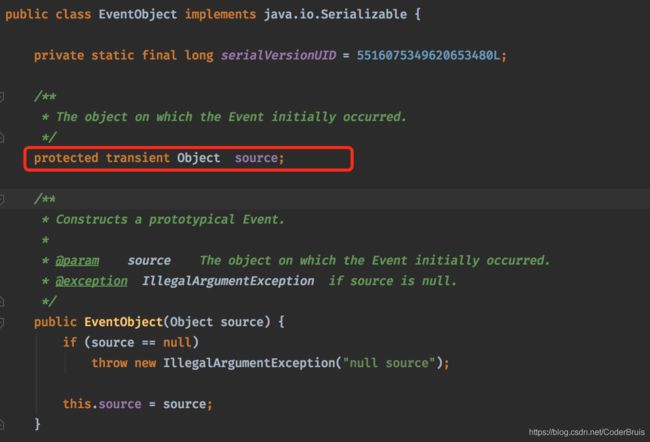
可以看到SpringApplicationEvent定义的系统事件基本都围绕着SpringBoot框架的启动生命周期。


而在EventPublishingRunListener中播放的事件,就是SpringBoot系统事件发送顺序,顺序如下:

2. SpringBoot中的事件广播器
在EventPublishingRunListener内部中,有一个名为SimpleApplicationEventMulticaster的成员变量,它是一种广播器,专门用于管理SpringBoot中的监听器,并广播指定的类型事件。SpringBoot定义了一个事件广播器接口,用于抽象播放器的接口行为,该接口名称为:ApplicationEventMulticaster,看下它的实现类的层次结构:

因此可以知道,在SpringBoot中核心广播器就是SimpleApplicationEventMulticaster,所有管理监听器播放事件的工作都由SimpleApplicationEventMulticaster来完成。下面先来看下接口ApplicationEventMulticaster源码及注释:
/**
* ApplicationEventMulticaster接口的实现类用于管理多个ApplicationListener监听器,并对事件进行广播
*
* ApplicationEventMulticaster实际上就是作为Spring真正播放事件的一个代理。
*
* @author Rod Johnson
* @author Juergen Hoeller
* @author Stephane Nicoll
* @see ApplicationListener
*/
public interface ApplicationEventMulticaster {
/**
* 添加一个监听器用于触发所有事件
*/
void addApplicationListener(ApplicationListener listener);
/**
* 添加一个监听器的bean用于触发所有事件
*/
void addApplicationListenerBean(String listenerBeanName);
/**
* 从通知列表中移除一个监听器
*/
void removeApplicationListener(ApplicationListener listener);
/**
* 从通知列表中移除一个监听器的bean
*/
void removeApplicationListenerBean(String listenerBeanName);
/**
* 移除所有注册在广播器上的监听器。
*/
void removeAllListeners();
/**
* 在适当的监听器上播放ApplicationEvent事件
*/
void multicastEvent(ApplicationEvent event);
/**
* 在适当的监听器上播放ApplicationEvent事件
* 可以通过eventType来过滤需要播放的事件类型。
*/
void multicastEvent(ApplicationEvent event, @Nullable ResolvableType eventType);
}
接着看AbstractApplicationEventMulticaster抽象类源码,由于AbstractApplicationEventMulticaster方法较多,就挑几个核心方法进行讲解并学习。
AbstractApplicationEventMulticaster类注释可以总结成以下几点:
- ApplicationEventMulticaster接口的抽象实现,提供了基本的监听器注册功能。
- 默认情况下,框架不允许同一监听器有多个实例,因为监听器会被存放到set集合中。
- 通常ApplicationEventMulticaster接口的multicastEvent方法是留给子类SimpleApplicationEventMulticaster实现,它通过multicastEvent方法将所有事件广播到所有已注册的监听器,并在调用线程中播放事件。
下面是AbstractApplicationEventMulticaster类的定义以及成员变量:
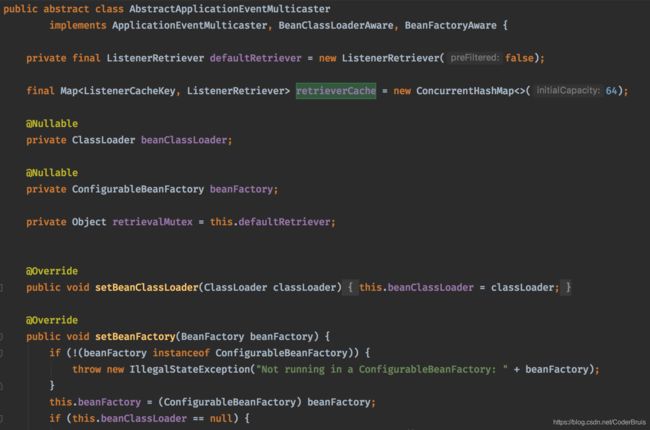
AbstractApplicationEventMulticaster不仅实现了ApplicationEventMulticaster,还实现了BeanClassLoaderAware以及BeanFactoryAware。在SpringBoot中,实现了XXAware,都会获得注入XX的能力,比如常见的ApplicationContextAware,就是拥有注入ApplicationContext的能力;所以AbstractApplicationEventMulticaster即拥有了注入BeanClass和BeanFactory的能力。
成员变量中,defaultRetriever是一个内部类,作为一个存储监听器实例的数据结构,其底层通过Set集合来存储监听器。retrieverCache是一个ConcurrentHashMap实现的内部缓存,用于在下次获取监听器时直接能从缓存中获取。retrievalMutex是一个Object对象,用作对象锁。
AbstractApplicationEventMulticaster已经把监听器存储好了,就等着广播器进行事件广播,而广播的方法就是视SimpleApplicationEventMulticaster#multicastEvent方法。
@Override
public void multicastEvent(ApplicationEvent event) {
// 广播事件
multicastEvent(event, resolveDefaultEventType(event));
}
@Override
public void multicastEvent(final ApplicationEvent event, @Nullable ResolvableType eventType) {
ResolvableType type = (eventType != null ? eventType : resolveDefaultEventType(event));
Executor executor = getTaskExecutor();
// 获取监听器集合
for (ApplicationListener listener : getApplicationListeners(event, type)) {
if (executor != null) {
// 如果有设置线程池,则调用线程池中的线程来调用监听
executor.execute(() -> invokeListener(listener, event));
}
else {
invokeListener(listener, event);
}
}
}
下面看下广播器是如何获取到监听器集合的。
2.1 AbstractApplicationEventMulticaster#getApplicationListeners
既然监听器存放在了播放器里,那么播放器肯定会提供一个获取监听器的方法,那么这个方法就是getApplicationListeners。
AbstractApplicationEventMulticaster#getApplicationListeners
protected Collection> getApplicationListeners(
ApplicationEvent event, ResolvableType eventType) {
// 获取事件的源,也就是SpringApplication对象。
Object source = event.getSource();
// 获取SpringApplication类对象
Class sourceType = (source != null ? source.getClass() : null);
ListenerCacheKey cacheKey = new ListenerCacheKey(eventType, sourceType);
// 从缓存中获取监听器
ListenerRetriever retriever = this.retrieverCache.get(cacheKey);
if (retriever != null) {
return retriever.getApplicationListeners();
}
if (this.beanClassLoader == null ||
(ClassUtils.isCacheSafe(event.getClass(), this.beanClassLoader) &&
(sourceType == null || ClassUtils.isCacheSafe(sourceType, this.beanClassLoader)))) {
// 异步地构建以及缓存ListenerRetriever
synchronized (this.retrievalMutex) {
retriever = this.retrieverCache.get(cacheKey);
if (retriever != null) {
// 从缓存中获取监听器
return retriever.getApplicationListeners();
}
retriever = new ListenerRetriever(true);
// 获取监听器集合
Collection> listeners =
retrieveApplicationListeners(eventType, sourceType, retriever);
// 将存放监听器的retriever存入ConcurrentHashMap中
this.retrieverCache.put(cacheKey, retriever);
return listeners;
}
}
else {
// 没有ListenerRetriever 缓存就没必要进行异步获取
return retrieveApplicationListeners(eventType, sourceType, null);
}
}
看下ListenerRetriever#retrieveApplicationListeners源码
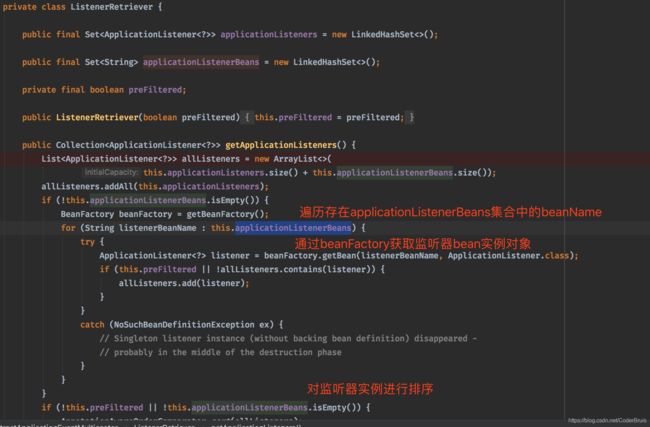
类ListenerRetriever的成员变量applicationListeners实际存储的就是spring.factories文件中注册的监听器。那问题来了,spring.factories文件里注册的监听器是什么时候注册进applicationListeners集合中的?
目光得回到EventPublishingRunListener的构造方法中,
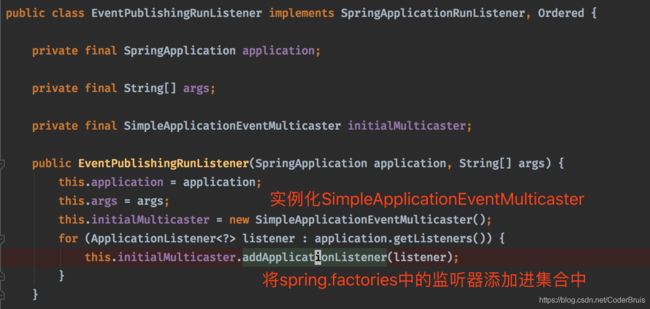

而EventPublishingRunListener构造方法是通过反射来方法来调用的。
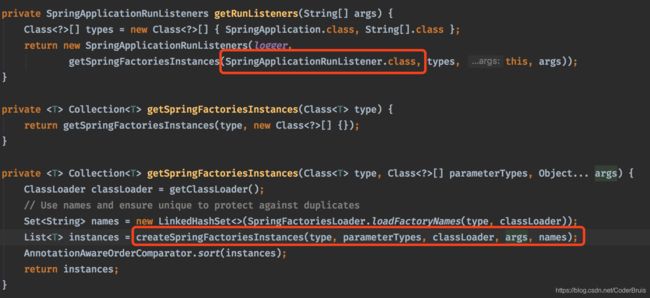
下图为SpringBoot如何将监听器添加进EventPublishingRunListener中的简易流程图。
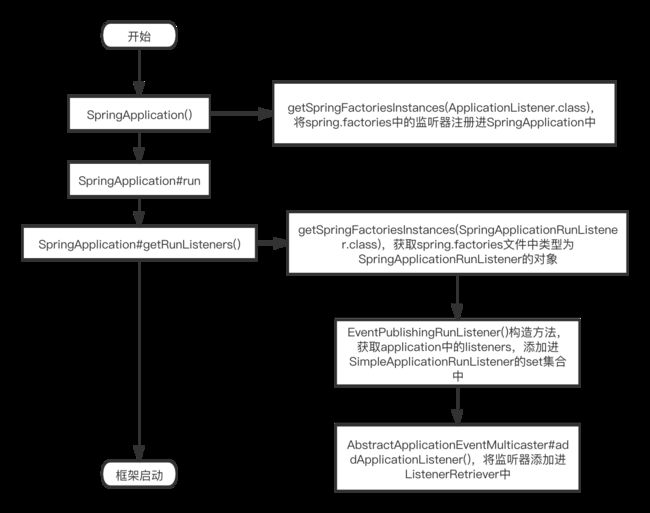
除此之外,还有一个重要方法AbstractApplicationEventMulticaster#supportsEvent,该方法有两个重载方法
supportsEvent(
ConfigurableBeanFactory beanFactory, String listenerBeanName, ResolvableType eventType)
supportsEvent(Class listenerType, ResolvableType eventType)
二者区别在于第一个supportsEvent方法需要传入beanFactory,用作于获取bean的申明类型。在尝试实例化bean定义的侦听器之前,请先检查其通用声明的事件类型,以对其进行早期过滤。
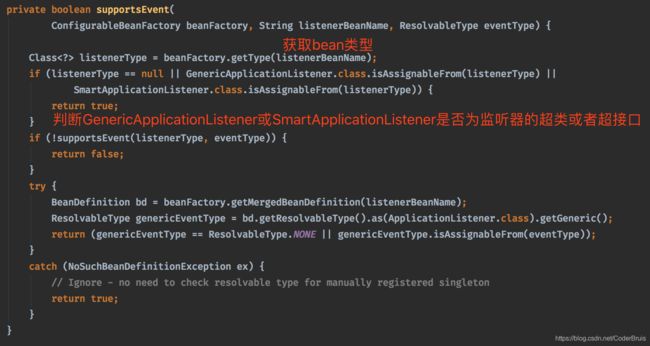
这里有一个比较陌生的类,就是ResolvableType,这是啥类?就如其名字,一个ResolvableType对象就代表着一种可解决的java类型,我们可以通过ResolvableType对象可以获取类型携带的信息 ,包括父类型、接口类型、泛型类型等。
3. SpringBoot中的事件广播器如何播放监听器中的事件?
上文已经分别讲解了事件、监听器、广播器,那么三者之间的调用关系又是怎样的关系呢?说的再好不如debug看下调用栈调用流程来的一清二楚。断点就打在SimpleApplicationEventMulticaster#multicastEvent方法中。
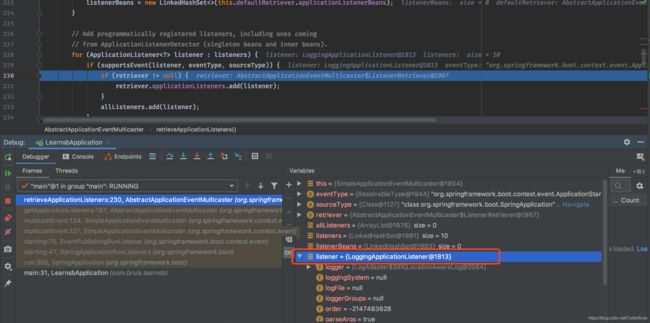
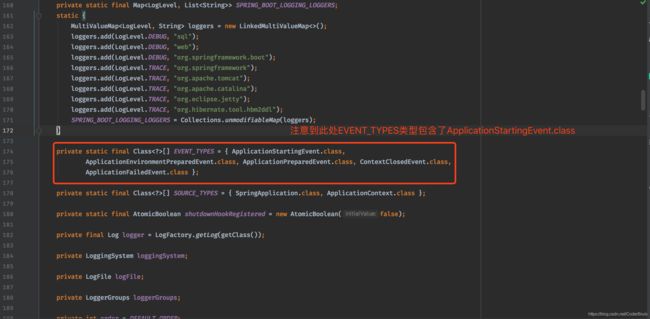
由于此处EVENT_TYPES类型包含了ApplicationStartingEvents.class,所以是符合类型的事件,因此会把LogginApplicationListener存放进Set集合中。
最终可以看到,对于starting方法,拥有感兴趣的ApplicationStartingEvents事件类型的监听器有下图的四种
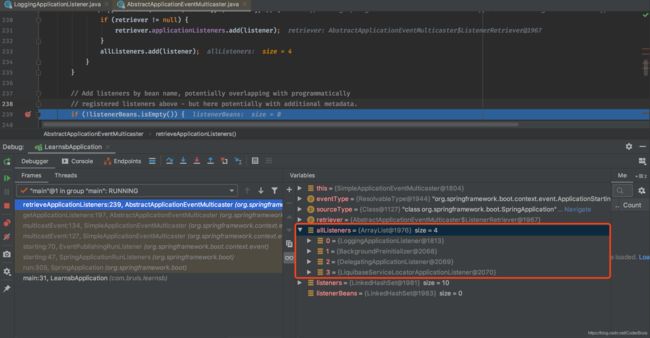
最终,会在SimpleApplicationEventMulticaster#doInvokeListener中进行监听器的onApplicationEvent调用,最终播放监听器。
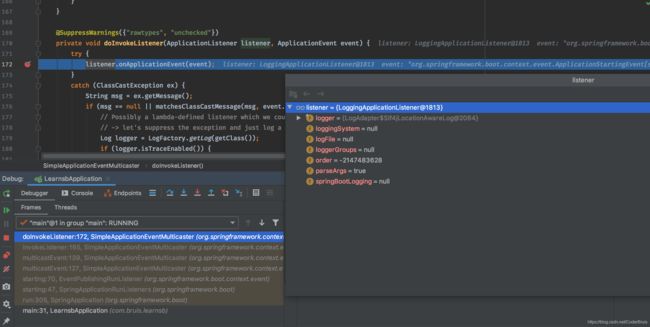
在SimpleApplicationEventMulticaster#multicastEvent方法中,由getApplicationListeners方法返回了拥有感兴趣事件类型的监听器实例集合,上图已经证实,在SpringBoot中对ApplicationStartingEvent事件类型感兴趣的监听器有四种。
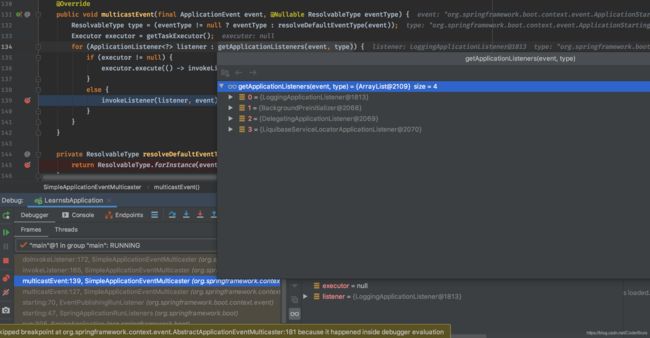
因此SpringBoot的广播器会依次播放这四种监听器的onApplicationEvent方法。
那么经过debug分析,事件、监听器、广播器之间的关系就已经变得明朗起来了。
3.1 事件、监听器、广播器之间的关系
对于广播器SimpleApplicationEventMulticaster,其作用就是存储监听器、根据具体的事件筛选出感兴趣的监听器,然后播放监听器;而监听器的onApplicationEvent方法会传入事件,来进行具体的播放逻辑。当然,广播器是作为EventPublishingRunListener的成员变量。因而在SpringApplication的生命周期中,通过广播器会分别调用对应感兴趣事件的监听器。
4. 模仿SpringBoot,实现自定义的事件与监听器
首先,定义一个天气事件抽象类
public abstract class WeatherEvent {
public abstract String getWeather();
}
定义两个天气事件
public class RainEvent extends WeatherEvent{
@Override
public String getWeather() {
return "rain...";
}
}
public class SnowEvent extends WeatherEvent{
@Override
public String getWeather() {
return "snow...";
}
}
接着定义一个事件监听器
public interface WeatherListener {
// 类似于SpringBoot监听器的onApplicationEvent方法
void onWeatherEvent(WeatherEvent event);
}
有了监听器接口,那么就要定义实现类
@Component
public class RainListener implements WeatherListener{
@Override
public void onWeatherEvent(WeatherEvent event) {
if (event instanceof RainEvent) {
System.out.println("hello " + event.getWeather());
}
}
}
@Component
public class SnowListener implements WeatherListener {
@Override
public void onWeatherEvent(WeatherEvent event) {
if (event instanceof SnowEvent) {
System.out.println("hello " + event.getWeather());
}
}
}
可以看到,SnowListener和RainListener类的onWeatherEvent方法会依据对应的天气Event进行过滤。
定义完了监听器以及事件之后,就还差广播器以及调用广播器播放事件的XXRunListener了。先定义一个事件广播器,包含了基础的添加监听器、移除监听器、播放事件的功能。
public interface EventMulticaster {
void multicastEvent(WeatherEvent event);
void addListener(WeatherListener weatherListener);
void removeListener(WeatherListener weatherListener);
}
抽象广播器类
@Component
public abstract class AbstractEventMulticaster implements EventMulticaster{
// 自动注入所有的天气监听器
@Autowired
private List listenerList;
// 播放天气事件
@Override
public void multicastEvent(WeatherEvent event) {
doStart();
// 遍历监听器,然后播放天气事件
listenerList.forEach(i -> i.onWeatherEvent(event));
doEnd();
}
@Override
public void addListener(WeatherListener weatherListener) {
listenerList.add(weatherListener);
}
@Override
public void removeListener(WeatherListener weatherListener) {
listenerList.remove(weatherListener);
}
// 记录广播器开始调用
abstract void doStart();
// 记录广播器结束调用
abstract void doEnd();
}
定义完了广播器,就运行广播器的XXRunListener了,下面定义一个WeatherRunListener,用于播放感兴趣的事件。
@Component
public class WeatherRunListener {
@Autowired
private WeatherEventMulticaster eventMulticaster;
public void snow() {
eventMulticaster.multicastEvent(new SnowEvent());
}
public void rain() {
eventMulticaster.multicastEvent(new RainEvent());
}
}
5. 总结
通过SpringBoot底层源码的分析以及模仿SpringBoot实现的自定义事件广播器,相信大家对广播器、监听器、事件以及调用广播器的XXRunListener运行监听类有了更深入的理解了。另外通过SpringBoot底层源码的分析后可以了解到,SpringBoot事件监听机制用的也是非常的广泛,除了文中介绍的EventPublishingRunListener监听器监听SpringApplication生命周期,还有ConfigFileApplicationListener会监听onApplicationEnvironmentPreparedEvent事件来加载配置文件application.properties的环境变量,所以说SpringBoot事件监听机制是非常重要的一个知识点,在SpringBoot的面试中也会经常面试到。
觉得作者写的不错的点个赞并关注作者。
本文代码在面的地址中已收录,文中出现的源码以及流程图都已收录进github中。
https://github.com/coderbruis/JavaSourceCodeLearning
